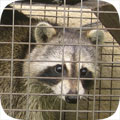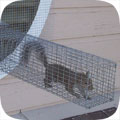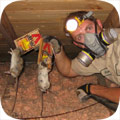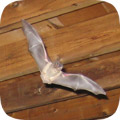- gonzales@wildlifeanimalcontrol.com
Call 24/7 for a free quote:
225-289-4143
Gonzales Wildlife Animal Control
Professional Wildlife Removal Company Servicing Gonzales, LA
If you have a problem with wildlife in your Gonzales home, your best option is to hire a company that specializes in Louisiana wildlife removal only. This is a specialty business, and regular pest control companies do not use the proper techniques to solve animal problems. I have spent many years reviewing Louisiana and Gonzales, and I recommend the following:
Wildlife Removal Baton Rouge
Cell Phone: 225-289-4143
NOTE: If you have a dog or cat problem, call Ascension Parish Animal Services: 225-675-6557

Wildlife Removal Baton Rouge specializes primarily in removing animals from attics of homes and buildings - this includes squirrels in attics, raccoons, and rats or mice in homes. Louisiana also has a documented problem with
bats in buildings, and Wildlife Removal Baton Rouge is specially trained in bat removal. They also perform general wildlife trapping services, such as the capture and removal of skunks or opossums on the
property. Call 225-289-4143 to discuss your critter problem and schedule a same-day or next-day appointment. Click here to learn more about what prices we charge in 2020.
When hiring a company to solve your wild animal problem, you want these features:
- Specializes in wildlife removal, not pest control
- Fully Louisiana and Ascension Parish licensed and insured
- Works 7 days per week (critters don't take weekends off)
- Performs full building inspections: enters and inspects attic
- Performs exclusion repairs, with guarantee against animal re-entry
- Offers cleanup of biohazardous wildlife waste
Wildlife Removal Baton Rouge is a full-service Gonzales wildlife removal company. This is very different from a regular Gonzales pest control company. The pest control companies spray poison to kill insects. This is not at all
similar to wildlife removal. Wildlife Removal Baton Rouge performs a full inspection of the home or property, and determines why the animal(s) are there, and if inside a building, how the animals got inside. All
animals (including rodents) are trapped and removed, or if possible, removed from the building using special exclusion devices. Once the animals are gone, preventative repairs are essential, and
cleanup is sometimes recommended.
 Gonzales wildlife trapping - it's not as simple as it may seem. It's illegal in Louisiana to trap without a license. Trap type is very important and there are many different types, bait is somewhat relevant, trap placement
is vital, and there are dozens of small things that are very important to know.
Safety is a concern. Then once the animal is trapped, it must be removed and dealt with in the proper manner according to Louisiana law. We offer Gonzales raccoon removal. Read more about how to get rid of raccoons.
Gonzales wildlife trapping - it's not as simple as it may seem. It's illegal in Louisiana to trap without a license. Trap type is very important and there are many different types, bait is somewhat relevant, trap placement
is vital, and there are dozens of small things that are very important to know.
Safety is a concern. Then once the animal is trapped, it must be removed and dealt with in the proper manner according to Louisiana law. We offer Gonzales raccoon removal. Read more about how to get rid of raccoons.
 Animals in attics - this is our specialty at Wildlife Removal Baton Rouge. Many types of animals like to live in attics. This includes squirrels, raccoons, rats, mice, bats, birds, and even possums. Critters like to go into attics for a safe place to live
and raise their young. Removing animals from attics is very complex work, partly because of the presence of baby animals. If you need Gonzales squirrel removal, we can remove all the squirrels from your attic, and seal out any future ones. Read more about how to get rid of squirrels.
Animals in attics - this is our specialty at Wildlife Removal Baton Rouge. Many types of animals like to live in attics. This includes squirrels, raccoons, rats, mice, bats, birds, and even possums. Critters like to go into attics for a safe place to live
and raise their young. Removing animals from attics is very complex work, partly because of the presence of baby animals. If you need Gonzales squirrel removal, we can remove all the squirrels from your attic, and seal out any future ones. Read more about how to get rid of squirrels.
 Rodent control must be done in a very specific way. First off, the most important thing is that all the openings that rats and mice can use to enter a house be sealed. Then all the rodents must be physically trapped and removed.
Never, ever use poison! Most Gonzales exterminators will just use this lazy poison technique to kill rodents, and it causes more harm than good - dead stinky rats, and it doesn't solve the problem. Call us for correct Gonzales rat removal. Read more about how to get rid of rats.
Rodent control must be done in a very specific way. First off, the most important thing is that all the openings that rats and mice can use to enter a house be sealed. Then all the rodents must be physically trapped and removed.
Never, ever use poison! Most Gonzales exterminators will just use this lazy poison technique to kill rodents, and it causes more harm than good - dead stinky rats, and it doesn't solve the problem. Call us for correct Gonzales rat removal. Read more about how to get rid of rats.
 Bat removal is a highly specialized task. Louisiana is known to have colonizing bats who often live in buildings. Bats love attics. If not removed, the colony can grow to a very large size over the years. The bat droppings are often corrosive and
cause health risks. The same goes for bird droppings on or in buildings. We perform Gonzales pigeon removal and bird control. But our specialty is Gonzales bat removal. We remove 100% of the bat colony and seal the building so that it's totally bat-proof. Read more about how to get rid of bats.
Bat removal is a highly specialized task. Louisiana is known to have colonizing bats who often live in buildings. Bats love attics. If not removed, the colony can grow to a very large size over the years. The bat droppings are often corrosive and
cause health risks. The same goes for bird droppings on or in buildings. We perform Gonzales pigeon removal and bird control. But our specialty is Gonzales bat removal. We remove 100% of the bat colony and seal the building so that it's totally bat-proof. Read more about how to get rid of bats.
 If you have animals inside a house, no job is complete without proper exclusion repairs. If you simply hire a Gonzales trapper who only removes the critters, then the problem will return. You need to hire a Gonzales wildlife control company that identifies 100% of the animal entry points
into your building, and seals them shut with professional repairs. In addition, in many cases animals have left waste or contamination behind, and you'll want a company that can provide professional cleaning services. Wildlife Removal Baton Rouge does both.
If you have animals inside a house, no job is complete without proper exclusion repairs. If you simply hire a Gonzales trapper who only removes the critters, then the problem will return. You need to hire a Gonzales wildlife control company that identifies 100% of the animal entry points
into your building, and seals them shut with professional repairs. In addition, in many cases animals have left waste or contamination behind, and you'll want a company that can provide professional cleaning services. Wildlife Removal Baton Rouge does both.
The above are just some of the services offered by Wildlife Removal Baton Rouge. We also trap and remove animals that destroy lawns, such as moles, or digging animals. Sometimes animals like opossums will live under buildings, steal pet food, raid garbage cans, etc.
Read about how to get rid of opossums. Skunks commonly live under sheds or decks, and set up a den. We can trap and remove them without them spraying. Read about how to get rid of skunks. Wildlife Removal Baton Rouge
also provides dead animal removal in Gonzales. If you need help with any other wildlife conflict, from a fox, beaver, groundhog, or any other critter, we can solve it. We also do Gonzales snake removal - most of the snakes in Louisiana are not venomous, but
call us if you want safe removal, or read about how to get rid of snakes in Gonzales. And remember, we are a private business, not Ascension
Parish Animal Control Services, so if you have a dog or cat problem, call the
Parish at 225-675-6557.
Ascension Parish animal services does not handle any wildlife issues.
Wildlife Removal Baton Rouge: 225-289-4143
Gonzales Pricing Info For Year 2020
 Every wildlife removal situation is different, from the species of animals involved, the location of the animal inside a house or outside, the extent of repairs or cleanup, etc. It's impossible to give one-size-fits-all prices. Examples MIGHT include:
Every wildlife removal situation is different, from the species of animals involved, the location of the animal inside a house or outside, the extent of repairs or cleanup, etc. It's impossible to give one-size-fits-all prices. Examples MIGHT include:
Small Job: For example, a one-stop job to remove an animal in the yard: $100 on up
Medium Job: For example, getting critters out of your house with minor repairs: $300 on up
Large Job: For example, a project involving many service trips and complex work: $500 on up
Give us a phone call now and tell us about your wildlife issue and we will be able to give you a price estimate over the phone. If you're cool with it, we can schedule a same-day or next-day appointment if you like. Our prices are fair, and a good value because we do the job right, the first time.
Gonzales Wildlife Tip #1:
The Pigmy Rattlesnake: Appearance, Biology, Life Cycle, Habitat, Diet, Behavior
There are three types of rattle snakes and the pigmy rattle-snake is just one of them. These snakes are found in the North America and they are known to be among the poisonous snakes in the United States. The pigmy rattlesnake is among the snakes in the pit viper family and they normally get their prey through ambush. That is means they do not go in hunt for any animal rather they usually sit at a spot and wait for their prey to come to them to strike accurately with the help of the heat sensory organ.
The Appearance
The Pigmy rattlesnakes have comparatively short body and there is dark line running through the side of each eye. There is circular spots running down the middle of the back together with interruption of thin reddish-orange stripe that move along the middle of the body. The western specie Pigmy Rattlesnakes have weak formed stripe. The belly is white in color with lots of dark spots. The color of this snakes and the size are the reason why people normally find it difficult to notice the presence.
Biology and Life Cycle
Pigmy rattle snake is native to southeastern part of United States and it is highly venomous. They are known with many names including spotted rattlesnakes, ground rattlesnakes, grey rattlesnakes and small rattlesnakes. The male and female pigmy rattle snakes are almost same size which is half a meter. They mating season is usually during spring and most of the snakes normally give birth in August. The snakes are also ovoviviparous meaning that they normally born their young alive. The female usually give birth to about 5-8 younglings. The young normally look a bit different from the adult as they have lighter hue coloration when compared to the adult. After their second year of birth the young normally grow into maturity and ready to reproduce and they are always independent from their mother from after birth.
Habitat and Diet
Pigmy rattlesnakes usually prefer to lice live in the burrows of other animals. They do not dig their own burrows rather will prefer to live in the one vacated by other animals. One of the animal burrows you can find pigmy rattle snakes is the Gopher Tortoise. The snakes also love to live in woodland with litter of leaves as well as in the woodland with mixed of forest. As for their diet some of the things they love to eat include small frogs, lizard, insects, and other smaller mammals. They normally hide under a camouflaged leave litter and wait for their prey to come by.
Behavior
Despite the fact that Pigmy snake is smaller in size it is not in any way calmer or docile when compare with other snakes. But, it does not move around to look for trouble. The only thing is that it can strike when it feels cornered and threatened by human or other animals. Also, due to their small nature coupled with their color it normally administers bite before human will realize the presence.
Gonzales Wildlife Tip #2:
Louisiana Wildlife Information:
Louisiana State bird: Brown pelican
State mammal: Black bear
State reptile: American alligator
State amphibian: American green tree frog
State fish: White crappie
State insect: European honey bee
Louisiana is famous for the devastation caused by Hurricane Katrina. The state sits against the Gulf of Mexico, and much of the southern region is below sea level. Because of this, when Louisiana gets hit by a tropical storm or a hurricane, it gets hit pretty hard. That same region which is prone to storms from the ocean is comprised mostly of watery marshes, swamps, and bayous. The northern part of the state is hilly but not mountainous. Overall, the climate is warm and humid. The summers are hot, and the winters are very mild. During the cooler months, the state is prone to substantial rainfall.
The areas in the mainland region of Louisiana are no longer dominated by the Florida panther, a large feline which used to roam many of the southern states. According to the local authorities, the big cat is considered extinct within the state. Now, aside from coyotes, the black bears tend to keep the public on their toes. Louisiana boasts two different types of black bear, the American black bear and the Louisiana black bear. The differences between the two are very subtle, and Louisiana black bears tend to be smaller and leaner than the standard American black bear. At first glance, however, it is very difficult to tell them apart. While bears are found in all regions of the state, they are not considered very dangerous. Instead, the bears are looked at as nuisance animals for their raiding of bird feeders and garbage cans.
The black bears join the ranks of other pest animals like raccoons, skunks, armadillos, opossums, beavers, otters, squirrels, rats, and mice. All of these critters can be found in every region of Louisiana.
With so many miles of swamp land, it isn't surprising that alligators are one of the most dangerous animals in the state. Alligators thrive in the marshes along the coast, using the watery vegetation to conceal them as they stalk prey. Many of the large birds in the area like cranes and pelicans can fall victim if they don't pay close enough attention to the water's edge.
Alligators aren't the only reptiles to love Louisiana. The region is home to many different species of snakes, and it was once a habitat for a number of subspecies of sea turtles.
You can always call Wildlife Removal Baton Rouge, any time of day, at 225-289-4143, for a price quote for Gonzales wildlife control services. I am confident that this is the best choice amongst wildlife removal companies in Gonzales, LA.





































